At points through 2018, Ferrari had the best chassis and the best power unit. Its aim for 2019 must be a little more performance and greater consistency.
With the launch of its new SF90, its clear the car is not a radical step, but evolving the previous model within the new regulations. Its clever details are hidden not by the lightweight matte paint, but the similarity to last year’s car is striking. This evolutionary approach is similar to Mercedes and to a lesser extent Red Bull.
Front wing
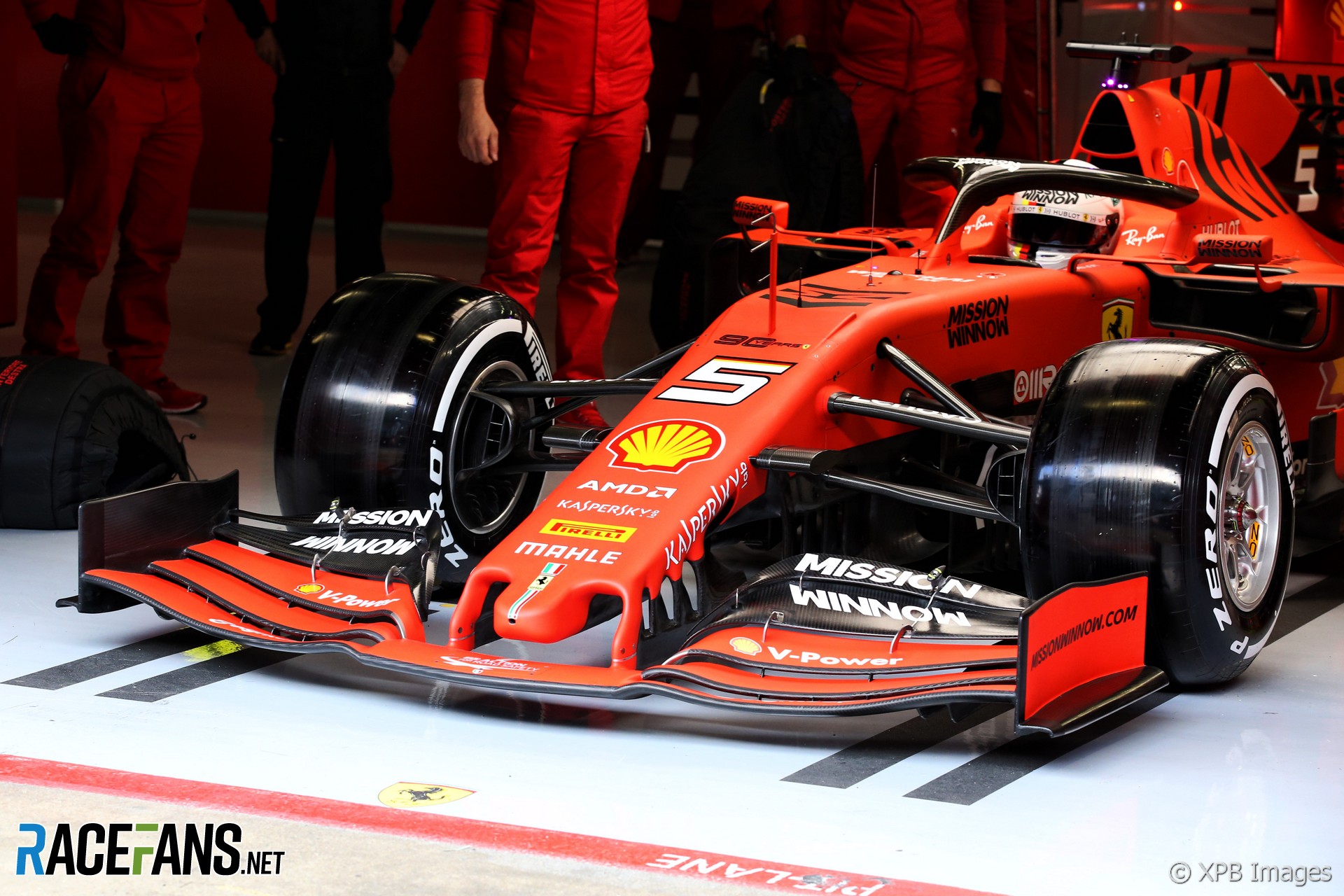
Ferrari have gone for a more considered approach to the front wing rules than the other teams running simpler Version 1.0 wings. So, we see a wing with the flaps which taper up from almost nothing at the endplate, before rising up and then steeply curving down at their inner tips. This concept is taken to an extreme by Ferrari power unit customer Alfa Romeo.
What Ferrari have done is clearly break up the three functions of the front wing; downforce, outwash and Y250. Any front wing needs to create downforce, but contrary to popular understanding, F1 front wings do not have to be massively powerful. They only need to create enough load to balance the downforce created by the rear wing and diffuser. This is easily achieved with just the middle span of each wing.
Creating outwash is the job of the endplate and the outer spans of wing. Last year we saw endplates formed of a series of vanes, while the wings outer tips curled down to form a secondary inner endplate, directing airflow outwards.
Lastly the Y250 airflow is created by the inner tips of each wing. The Y250 term comes from the distance in millimetres from the car’s centreline, which is where the neutral centre section meets the outer wing section. The change in section naturally forms a vortex, which has been put to use by teams since 2009 to flow inside the front wheel and turn outwards ahead of the sidepods.
Advert | Become a RaceFans supporter and
This aero effect can be seen on damp days as a vapour trail emerging from behind the front tyre. In doing this the Y250 pushes the front tyre wake away from the car, so the combined effect of outwash and Y250 is a push-me pull-you effect of managing the tyre turbulence.
Ferrari, like Alfa Romeo, thought about what the new rules allow and don’t allow you to do for each of these three wing functions. So, they think the outwash effect is better to be created by the endplate alone, rather than an endplate joined by steep wing elements. Thus, the Ferrari wing flattened the wings to nearly nothing as they near the endplate. Next, the middle span is the steepest, this is the part creating the downforce, its clear of the front tyre and works efficiently to create enough downforce. There’s no question that this wing format, despite the smaller flap elements, cannot create the downforce required for the car. Lastly, the Y250 effect is still achieved with the steeply curved inner tips, much in the same way as it was in 2018, despite the regulation changes.
With this package its clear Ferrari have thought through its Version 2.0 wing, that is likely to be copied by other teams as they develop their next generation front wings.
Sidepods
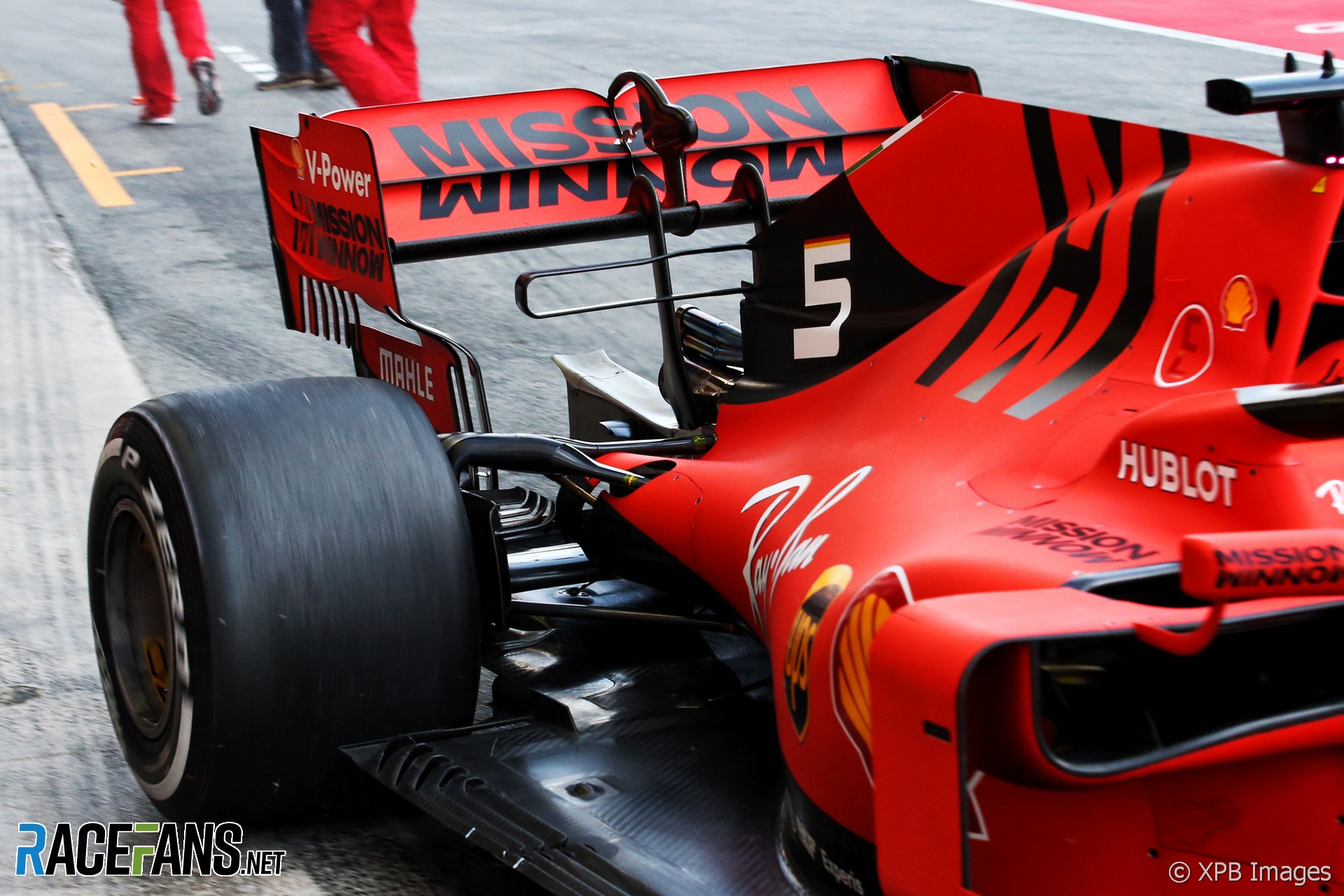
Unlike half of the grid, Ferrari already had the high-top concept in place: it pioneered the current sidepod fashion back in 2017. This year’s sidepod front is tidied up further from the SF71H, hidden within the myriad of vanes around the sidepod front is the inlet itself. This is quite narrow, but appears wider as the vanes surrounding it go to the full width allowed for sidepods. With the inlet being more of a single inlet, rather than the separate top and front inlets used in the previous two versions. The inlet still feeds air downwards and this is aided by the downturned vane spanning the inlet.
Ferrari also merge the bargeboards into the sidepod vanes in an effective manner, with the usual large side panels stepped in shape to meet the lower bargeboard rule.
Go ad-free for just £1 per month
>> Find out more and sign up
Engine cover
One of the team’s stated improvements from 2018 is the slimness of the rear end. This is done in a different way to other teams. It’s not the ‘coke bottle’ area that’s been slimmed as with Red Bull or Mercedes, but the upper bodywork. From the reshaped roll hoop inlet, that’s now smaller and more triangular than before, the cross section of the bodywork is much narrower. There’s still the bulge required for the inner airbox ducting, with the thin shark fin formed above, nearly the same depth as last year. Then, the general vertical area is much slimmer, so much so that the exhausts require a bulge as they pass through the engine cover. This change may be down to the lack of cooling radiators mounted above the engine\gearbox or the inlet plenum packaging that feeds the engine with air.
Tail pipes
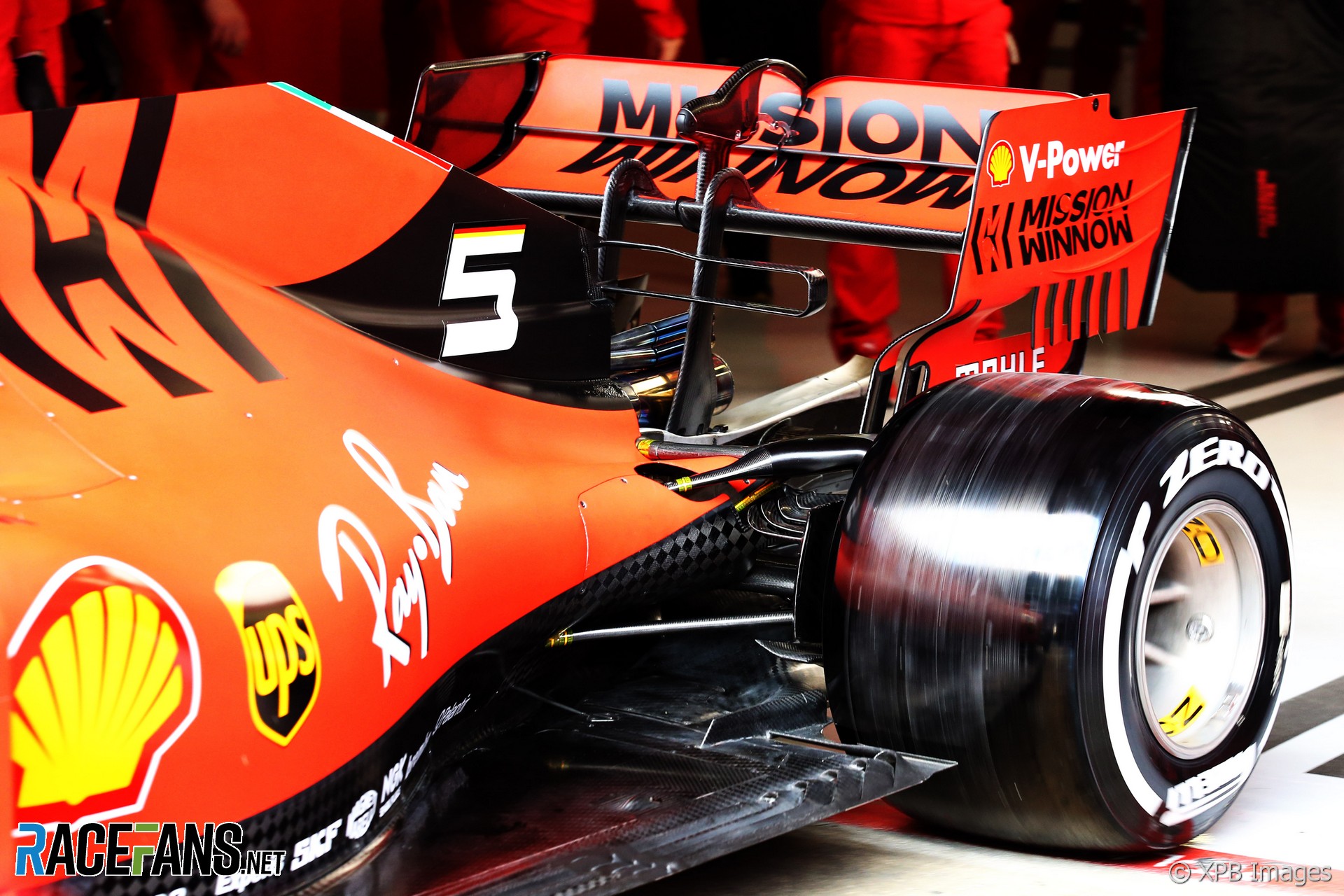
Evident on the Ferrari-powered Haas and Sauber cars, the exhausts are arranged in an unusual stacked format, with the two wastegate pipes mounted above the main tailpipe. This isn’t unique -Renault have run stacked exhausts before, albeit with just one wastegate pipe.
F1’s rules demand there is a separate wastegate pipe to the turbo’s tailpipe, in order to boost the noise the exhaust creates. Ferrari’s two wastegate pipes are in fact a bit of a decoy, as there’s a single wastegate and a single pipe exits towards the rear before splitting into two exit pipes.
In this position it’s unlikely that the exhausts have anything to do with blowing the rear wing, the wastegates aren’t run open when the downforce is required through corners and the top rear wing is too high to be blown, by the low exhausts. So, the odd packaging is likely to be a by-product of the slim engine cover philosophy, as the stacked exhausts are narrower, than a side-by-side pair having to route around the main tailpipe and rear wing mounts.
Rear wing
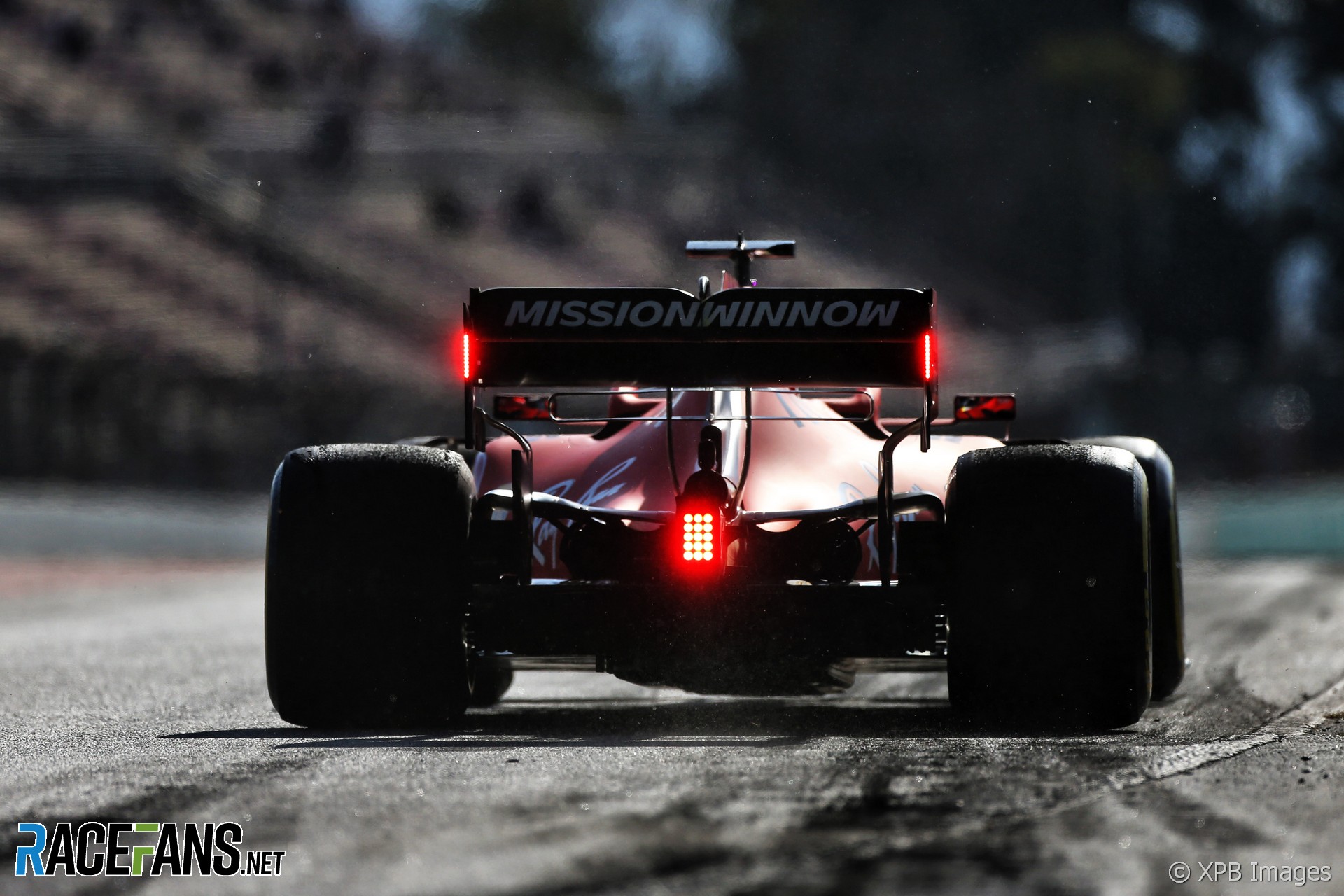
There’s a common theme evolving around rear wing endplate for 2019, with the wider top rear wing requiring a bigger crease in the endplates. Additionally, new rules close up the drag-reducing louvers that were made into the top corner of the endplate.
To regain the efficiency lost from the additional drag of the bigger wing and louvers, the teams are opening up the rear of the endplate to aid the wing’s airflow expansion. To lower the pressure below the wing, the endplate is opened up and hanging vanes filling the opening. These allow the air to expand horizontally behind the wing, preventing the endplate being too two-dimensional.
Advert | Become a RaceFans supporter and
2019 F1 season
- Crying in the Melbourne car park at 2019 grand prix was my career low – Ocon
- McLaren Racing reports reduced £71 million loss in 2019
- Kvyat: Hockenheim podium last year was “my biggest achievement” so far
- How the FIA’s new encrypted fuel flow meter targets Ferrari’s suspected ‘aliasing’ trick
- “He smashed my office door”: 23 must-see moments from ‘Drive to Survive’ season two




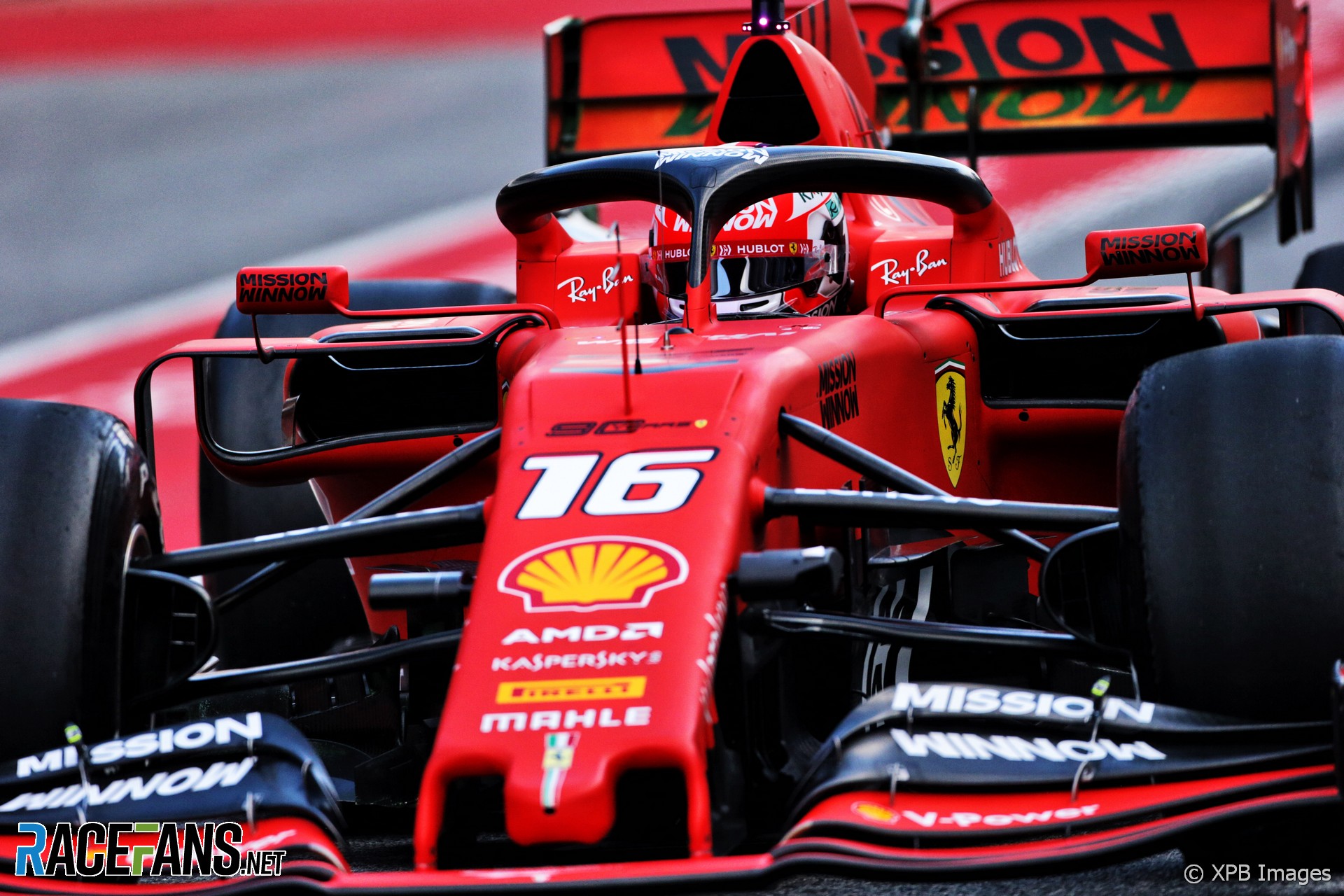
Phylyp (@phylyp)
19th February 2019, 12:25
Nice analysis, thank you!
spoutnik (@spoutnik)
19th February 2019, 12:58
Very insightful article! Amazing!
Alex Bkk (@alex-bkk)
19th February 2019, 13:06
That’s on badass car!
Alex Bkk (@alex-bkk)
19th February 2019, 13:08
one* THF… no edit option.
StefMeister (@stefmeister)
19th February 2019, 13:24
I hate how the matt paint there using makes it look orange on TV.
Joao (@johnmilk)
19th February 2019, 14:03
knowing Ferrari, they will change it and won’t admit they did and will tell us the “new colour” was always there from the start
MrBoerns (@mrboerns)
19th February 2019, 16:29
I kind of generally dislike the notion of ferrari joining in on a trend like the matte paint. It is kind of Ferrari’s thing that design trends like that do not concern them. (yeah yeah yeah save weight, what a bunch of bull)
socksolid (@socksolid)
19th February 2019, 13:42
One of the big difference between ferrari and mercedes cars is the front wing edges near the end plates. Mercedes has the wing elements at very high angle whereas everybody else have them flattened out. I wonder what are the tradeoffs for both designs?
GeeMac (@geemac)
19th February 2019, 13:51
@socksolid There is another key difference there too: Ferrari (and every other team on the grid) angles the endplates outward slightly whereas Mercedes have angled theirs inwards.
Fudge Kobayashi (@)
19th February 2019, 15:44
@socksolid the article literally addresses this in great detail. Wonder no more…
socksolid (@socksolid)
19th February 2019, 19:36
So what are the trade offs? The article (while well written and interesting) does not directly compare ferrari and mercedes designs. All it says is that ferrari seems to be using just the endplates to steer the air while supposedly some other teams are using more of the wing to create that effect.
Kevin Wong (@fongu)
19th February 2019, 14:40
Nice read. Would be good to get a comparison of the rear suspension and rear brake ducts as this area is getting increasingly populated and complex, and how that interacts with the diffuser and the endplates
Robert
19th February 2019, 15:59
Great article Scarbs, I love these! I just have to elaborate on this detail. I might be misinterpreting the explanation, but it sounds like you are suggesting the hanging louvers by the crease in the rear wing endplate is there to allow air from under the wing to expand by passing through to the outside of the endplate? It looks as the opposite is what happens considering how the vanes are angled, and that would make sense to an amateur like me. Like I said, I probably just misinterpreted.
Inside the endplate, under the wing, the pressure should be lower than outside of the endplate. The steeply angled crease in the endplate (mandated by the rules) would therefor generate lift by having a low pressure inside and above it and a higher pressure outside and below it. Considering the general airflow in this region is also angled upwards the creased surface would also effectively be a large blockage generating drag. Lift and drag is a bad combination. The hanging vanes concept keeps the endplates legal because viewed from the side it is fully covered. But it eliminates the sloped surface of the crease allowing air to pass through from the outside to the inside, thereby reducing drag and improving downforce by removing an element of lift. Maybe it slightly reduces the downforce of the main rear wing by raising the pressure under it, but I guess that loss is smaller than the gains.
GnosticBrian (@gnosticbrian)
19th February 2019, 16:43
“At points through 2018, Ferrari had the best chassis and the best power unit” – sadly, at no point did they have the best driver.
Lewisham Milton
19th February 2019, 17:11
But can it follow another car round a corner…?
Rick D. (@partsguy20)
19th February 2019, 17:59
Looks like a very fast car so far. Hopefully all of their good work isn’t rendered irrelevant by poor race strategy and a mountain of driver mistakes.
racerdude7730 (@racerdude7730)
19th February 2019, 23:39
I had not noticed how much the engine cover had shrunk on this car until it was pointed out it shrunk even bellow the exhaust pipes. It’s a great touch and something other teams would wanna do to help all the rear aero work. I could see Ferrari at some point using the style win Renault used today that creates extra down force from a creative endplate setup
racerdude7730 (@racerdude7730)
19th February 2019, 23:41
Wing*
YellowFlash (@iceman241086)
20th February 2019, 7:03
Great to see an in-house analysis article from @scarbs with Racefans! Great going @keithcollantine @scarbs!